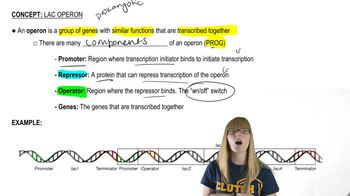Bacterial genomes frequently contain groups of genes organized into operons. What is the biological advantage of operons to bacteria? Identify the regulatory components you would expect to find in an operon. How are the expressed genes of an operon usually arranged?
Table of contents
- 1. Introduction to Genetics51m
- 2. Mendel's Laws of Inheritance3h 37m
- 3. Extensions to Mendelian Inheritance2h 41m
- 4. Genetic Mapping and Linkage2h 28m
- 5. Genetics of Bacteria and Viruses1h 21m
- 6. Chromosomal Variation1h 48m
- 7. DNA and Chromosome Structure56m
- 8. DNA Replication1h 10m
- 9. Mitosis and Meiosis1h 34m
- 10. Transcription1h 0m
- 11. Translation58m
- 12. Gene Regulation in Prokaryotes1h 19m
- 13. Gene Regulation in Eukaryotes44m
- 14. Genetic Control of Development44m
- 15. Genomes and Genomics1h 50m
- 16. Transposable Elements47m
- 17. Mutation, Repair, and Recombination1h 6m
- 18. Molecular Genetic Tools19m
- 19. Cancer Genetics29m
- 20. Quantitative Genetics1h 26m
- 21. Population Genetics50m
- 22. Evolutionary Genetics29m
12. Gene Regulation in Prokaryotes
Lac Operon
Problem 1b
Textbook Question
What evidence established that lactose serves as the inducer of a gene whose product is related to lactose metabolism?
 Verified step by step guidance
Verified step by step guidance1
Understand the concept of an inducer: An inducer is a molecule that initiates or enhances the expression of specific genes. In the case of lactose metabolism in bacteria, lactose acts as the inducer by interacting with the regulatory proteins controlling the expression of genes involved in lactose utilization.
Review the experimental setup: Researchers studied the lac operon in *E. coli*, a model system for understanding gene regulation. They observed that the presence of lactose in the growth medium led to the production of enzymes like β-galactosidase, which are necessary for lactose metabolism.
Analyze the key experiments: One pivotal experiment involved growing *E. coli* in media with and without lactose. In the presence of lactose, the production of β-galactosidase and other enzymes increased significantly, while in its absence, these enzymes were produced at very low levels or not at all.
Consider the role of mutants: Mutants that could not metabolize lactose (e.g., lacZ mutants) were studied. These mutants lacked functional β-galactosidase, confirming that the enzyme was essential for lactose metabolism. Additionally, mutants with defects in the lacI gene (repressor) showed constitutive expression of the lac operon, indicating that lactose interacts with the repressor to induce gene expression.
Conclude based on the evidence: The experiments demonstrated that lactose or its derivative (allolactose) binds to the lac repressor, causing it to release from the operator region of the lac operon. This allows RNA polymerase to transcribe the genes required for lactose metabolism, establishing lactose as the inducer.
 Verified video answer for a similar problem:
Verified video answer for a similar problem:This video solution was recommended by our tutors as helpful for the problem above
Video duration:
38sPlay a video:
Was this helpful?
Key Concepts
Here are the essential concepts you must grasp in order to answer the question correctly.
Inducer in Gene Regulation
An inducer is a molecule that initiates gene expression by binding to a repressor protein, thereby allowing transcription to occur. In the context of lactose metabolism in bacteria, lactose acts as an inducer for the lac operon, which encodes enzymes necessary for the breakdown of lactose. This concept is crucial for understanding how bacteria adapt to available nutrients.
Recommended video:
Guided course

Induced Mutations
Lac Operon Model
The lac operon is a well-studied model of gene regulation in E. coli, consisting of genes that encode proteins for lactose metabolism. It includes a promoter, operator, and structural genes (lacZ, lacY, and lacA). The operon is regulated by the presence or absence of lactose, illustrating how bacteria can efficiently manage their resources based on environmental conditions.
Recommended video:
Guided course

Lac Operon Overview
Experimental Evidence in Genetics
Experimental evidence in genetics often involves techniques such as gene knockout, reporter assays, and biochemical assays to demonstrate the function of specific genes or molecules. In the case of lactose as an inducer, experiments showed that the presence of lactose led to increased expression of lac operon genes, providing direct evidence of its role in regulating gene expression related to lactose metabolism.
Recommended video:
Guided course

Descriptive Genetics
Related Videos
Related Practice
Textbook Question
849
views


